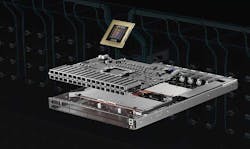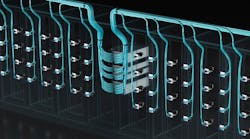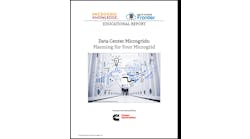NVIDIA envisions a future with virtual worlds powered by augmented reality and AI, tied together with powerful networks. And NVIDIA is building the hardware and software to enable that vision.
The high-tech future is at the heart of NVIDIA’s news at today’s GTC Fall 2021, where NVIDIA rolled out a portfolio of new products for high-performance computing (HPC) and research. Amid growing hubbub about metaverse technology, NVIDIA showcased how its Omniverse platform can create simulations of people, business equipment, and even the Planet Earth itself.
“A constant theme you’ll see (is) how Omniverse is used to simulate digital twins of warehouses, plants and factories, of physical and biological systems, the 5G edge, robots, self-driving cars, and even avatars,” said Jensen Huang, the founder and CEO of NVIDIA.
NVIDIA’s approach to virtual world-building is focused squarely on developers and business. In his GTC keynote, Huang introduced Omniverse Avatar, a platform for creating interactive AI avatars and digital assistants that can be customized for use in banking, retail and customer support.
NVIDIA was founded in 1993, and its graphics processing units (GPUs) quickly became an essential tool for gamers yearning for more horsepower. The company has become one of the biggest beneficiaries of the rise of specialized computing, gaining traction with workloads in supercomputing, artificial intelligence (AI) and connected cars.
At GTC, it was clear that NVIDIA sees a big future in building virtual worlds and simulations.
“The dawn of intelligent virtual assistants has arrived,” said Huang. “Omniverse Avatar combines NVIDIA’s foundational graphics, simulation and AI technologies to make some of the most complex real-time applications ever created. The use cases of collaborative robots and virtual assistants are incredible and far-reaching.”
Quantum-2 Brings 400Gbps InfiniBand
For data center operators, NVIDIA unveiled Quantum-2, a 400Gbps InfiniBand networking platform that integrates a switch, network adapter and Bluefield-3 DPU (data processing unit). NVIDIA says Quantum-2 combines enhanced performance with less use of power and space. The new platform offers multi-tenant performance isolation to prevent the activity of one tenant from disturbing others (the “noisy neighbor” problem), as well as a congestion control system with cloud-native capabilities.
Quantum-2 leverages InfiniBand interconnect technology from NVIDIA’s 2019 acquisition of Mellanox, Interconnects are network components that allow compute nodes to communicate with each other. InfiniBand is a networking architecture used primarily in interconnects for supercomputing and HPC, while Ethernet dominates in the world of cloud and data centers.
The NVIDIA ConnectX-7 400G InfiniBand In-Network Computing adapter. (Image: NVIDIA)
NVIDIA also offers an Ethernet networking platform, but believes the latency and performance of InfiniBand make the case for broader adoption in enterprise and cloud.
“The requirements of today’s supercomputing centers and public clouds are converging,” said Gilad Shainer, senior vice president of Networking at NVIDIA. “They must provide the greatest performance possible for next-generation HPC, AI and data analytics challenges, while also securely isolating workloads and responding to varying demands of user traffic. This vision of the modern data center is now real with NVIDIA Quantum-2 InfiniBand.”
The Quantum-2 InfiniBand switch features 57 billion transistors on 7-nanometer silicon, making it slightly bigger than the NVIDIA A100 GPU with 54 billion transistors. It features 64 ports at 400Gbps or 128 ports at 200Gbps and will be offered in a variety of switch systems up to 2,048 ports — more than 5x the switching capability over the previous generation, Quantum-1.
LaunchPad Goes Global at Equinix
NVIDIA also announced the global expansion of LaunchPad, an AI-on-demand offering at Equinix data centers that was initially available in North America, but now rolls out to sites in Europe and Asia as well. The program provides a “curated lab experience” for customers to evaluate NVIDIA hardware and software.
LaunchPad is part of NVIDIA’s push to make its technology available to a broader set of customers, including those who may not have massive budgets or data center infrastructures that can support high-density deployments.
“The NVIDIA LaunchPad program helps enterprises worldwide quickly determine their AI requirements on the same stack they can purchase and deploy, giving them a running start with support from NVIDIA before a single server even ships,” said Manuvir Das, head of Enterprise Computing at NVIDIA.
“AI is becoming ubiquitous, and as enterprises race to integrate it into their products and services, NVIDIA’s LaunchPad program at Equinix helps companies get going faster than ever before,” said Steve Steinhilber, vice president of Business Development at Equinix. “After a LaunchPad experience, businesses can run their NVIDIA-accelerated AI workloads at Equinix locations globally to take advantage of close proximity to our extensive ecosystem of cloud, network and technology partners.”
Equinix is the first data center partner for LaunchPad, and will now have the service available at nine sites – three in the US, four in Europe and two in Asia.
A stylized avatar of NVIDIA founder and CEO Jensen Huang, part of Omniverse Avatar’s Project Tokkio, a reference application for interactive AI avatars for customer service. (Image: NVIDIA)
Getting Meta With Virtual Avatars
Many of the headlines from GTC are likely to focus on the Omniverse platform, which serves a buzzy niche that is in the news with Facebook’s recent decision to change its name to Meta and focus on the development of metaverse for social networking.
Omniverse Avatar creates interactive characters with ray-traced 3D graphics that can see, speak, converse on a wide range of subjects, and understand naturally spoken intent. In his keynote address at GTC, Huang shared examples of avatars for customer support and video conferencing.
In a demonstration of Project Tokkio, Huang showed colleagues engaging in a real-time conversation with an avatar crafted as a toy replica of himself — conversing on such topics as healthcare diagnosis and climate science. He then showed a demo of a customer-service avatar in a restaurant kiosk, able to see, converse with and understand two customers as they ordered veggie burgers, fries and drinks.
Huang also announced that NVIDIA will build a digital twin to simulate and predict climate change, E-2, or Earth Two.






